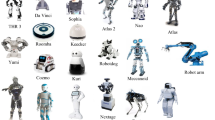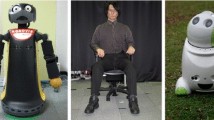Abstract
We have investigated actual and perceived human performance associated with a simple task involving walking and applied the developed knowledge to a human-robot interaction. Based on experiments involving walking at a “purposeful and comfortable” pace, parameters were determined for a trapezoidal model of walking: starting from standing still, accelerating to a constant pace, walking at a constant pace, and decelerating to a stop. We also collected data on humans’ evaluation of the accomplishment of a simple task involving walking: determining the transitions from having taken too short a period of time to an appropriate time and from having taken an appropriate time to having taken too long. People were found to be accurate in estimating the task duration for short tasks, but to underestimate the duration of longer tasks. This information was applied to a human-robot interaction involving a human leaving for a “moment” and the robot knows how long the task should take and how time is evaluated by a human.
Similar content being viewed by others
References
Hirasake E, Moore ST, Raphan T, Cohen B (1999) Effects of walking velocity on vertical head and body movements during locomotion. Exp Brain Res 127:117–130
Imai T, Moore ST, Raphan T, Cohen B (2001) Interaction of the body, head, and eyes during walking and turning. Exp Brain Res 136:1–18
Knoblock RL, Pietrucha MT, Nitzburg M (1996) Field studies of pedestrian walking speed and start-up time. Transp Res Rec 1538:27–38
Bohannon RW (1997) Comfortable and maximum walking speed of adults aged 20–79 years: reference values and determinants. Age Ageing 26:15–19
Brogan DC, Johnson NL (2003) Realistic human walking paths. In: Sixteenth international conference on computer animation and social agents (CASA)
Gates TJ, Noyce DA, Bill AR, Ee NV (2006) Recommended walking speeds for pedestrian clearance timing based on pedestrian characteristics. In: Proceeding of TRB 2006 annual meeting, transportation research board, Washington, DC
Rose J, Gamble JG (eds) (2005) Human walking, 3rd edn. Lippincott, Williams and Wilkins, Philadelphia
Lettre C, Contini R (1967) Accelerographic analysis of pathological gait. Technical report No. 1368.01, NY University School of Engineering and Science, New York
Buhusi CV, Meck WH (2006) Internal timing with gaps and distractors: Evaluation of the ambiguity, switch, and time-sharing hypotheses. J Exp Psychol, Anim Behav Processes 32:329–338
Zakay D (1990) The evasive art of subjective time measurement: Some methological dilemmas. In: Block RA (ed) Cognitive models of psychological time. Erlbaum, Hillsdale, pp 59–84
Zakay D, Block RA (1997) Temporal cognition. Curr Dir Psychol Sci 6:12–16
Trickett SB, Trafton JG (2007) “What if…”: The use of conceptual simulations in scientific reasoning. Cogn Sci 31(5):843–875
Breazeal C (2003) Towards social robots. Robot Auton Syst 42:167–175
Heerink M, Krose B, Evers V, Wielinga B (2010) Assessing acceptance of assistive social agent technology by older adults: the almere model. Int J Soc Robot 2:361–375
Trafton JG, Schultz AC, Bugajska MD, Mintz FE (2005) Perspective-taking with robots: Experiments and models. In: I workshop robot human interactions. IEEE Press, New York, pp 580–584
Kennedy WG, Bugajska MD, Marge M, Adams W, Fransen BR, Perzanowski D, Schultz AC, Trafton JG (2007) Spatial representation and reasoning for human-robot collaboration. In: Proceedings of the twenty-second conference on artificial intelligence (AAAI2007). AAAI Press, Vancouver, pp 1554–1559
Parke F, Waters K (1996) Computer facial animation. AK Peters, Natick
Simmons R, Adams W, Atrash A, Bugajska M, Coblenz M, MacMahon M et al (2003) GRACE: an autonomous robot for the AAAI robot challenge. In: AI Magazine, pp 51–72
Schultz AC, Adams W, Yamauchi B (1999) Integrating exploration, localization, navigation, and planning with a common representation. Auton Robots 6:293–308
Anderson JR (2007) How can the human mind occur in the physical universe? Oxford University Press, Oxford
Kennedy WG, Bugajska MD, Adams W, Schultz AC, Trafton JG (2008) Incorporating mental simulation for a more effective robotic teammate. In: Proceedings of the twenty-third conference on artificial intelligence (AAAI 2008). AAAI Press, Chicago, pp 1300–1305
Taatgen NA, van Rijn H, Anderson JR (2007) An integrated theory of prospective time interval estimation: the role of cognition, attention, and learning. Psychol Rev 114(3):577–598
Author information
Authors and Affiliations
Corresponding author
Rights and permissions
About this article
Cite this article
Kennedy, W.G., Trafton, J.G. How Long Is a Moment: The Perception and Reality of Task-Related Absences. Int J of Soc Robotics 3, 243–252 (2011). https://doi.org/10.1007/s12369-011-0098-7
Accepted:
Published:
Issue Date:
DOI: https://doi.org/10.1007/s12369-011-0098-7




